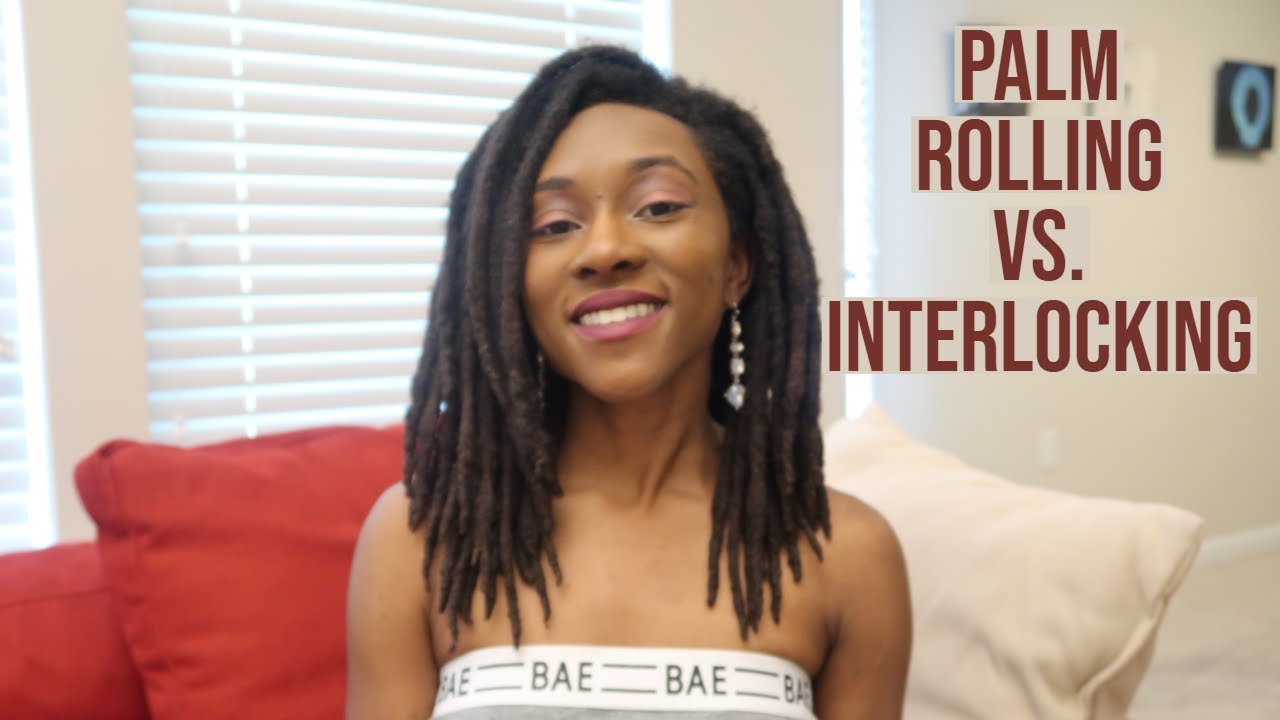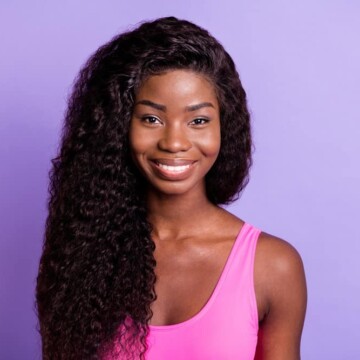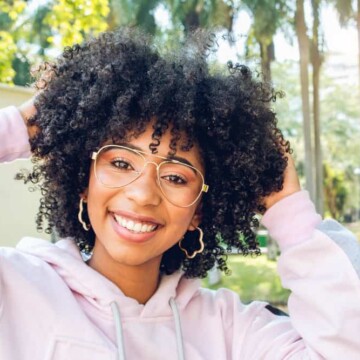
Palm rolling vs interlocking, which one is better? It can be tough to choose a loc maintenance technique, especially if you’re a loc newbie. Each maintenance method has its pros, cons, and purpose.
In this article, we’ll share pertinent information about each loc maintenance technique, highlight the differences, and help you decide which one is right for you.
Table of Contents
What Is Palm Rolling?
Palm rolling, also called retwisting, is a loc maintenance technique that requires you to twist or roll each loc between your palms. Some people use locking gel, oils, or creams to reduce flyaways and frizz. The goal of palm rolling is to give your locs a uniform, round shape.
Palm rolling can be used on all loc types (two-strand twist locs, braid locs, interlocks, etc.), from the starter loc stage to the mature stage. Many love palm rolling because it’s easy to learn and doesn’t take much time.

What Is Interlocking?
Interlocking is a more involved loc maintenance technique that involves pulling your loc through its roots in multiple directions using an interlocking tool. As you interlock, the new growth will be incorporated into the loc.
There are three interlocking variations, including:
- 2 Point Rotation - The 2 point rotation requires you to pull your loc through the roots from west to east and then north to south. You’ll repeat this pattern until there’s no more new growth to interlock. You can expect less dense locs with this rotation - it’s best for people who want their locs to be more puffy than rope-like.
- 3 Point Rotation - With the 2 point rotation, you’ll pull your loc from east to west, then north to south, then east to west again, and then south to north. Then start over, beginning with east to west. This rotation creates locs that are denser than those maintained with the 2 point rotation. But they won’t be as neat and rope-like as those maintained with the 4 point rotation.
- 4 Point Rotation - The 4 point rotation is the most popular rotation among loc’d folks. It requires you to go from east to west, then north to south, then west to east, and lastly south to north. That’s one full rotation. You’ll repeat this rotation until there’s no new growth left. This rotation gives you the neatest, most uniform locs. They’ll also be dense and least likely to slip.
Interlocking is ideal for starting locs as well as maintaining them. Those with Sisterlocks™ and microlocks usually use the interlocking method to maintain their new growth.

The Differences Between Palm Rolling and Interlocking
You now know the basics of palm rolling and interlocking, which gives you a good basic understanding. But to better understand each technique, it’s essential to know the differences between palm rolling and interlocking. We’ll take a look at them below:
- Tools. Palm rolling takes nothing more than your hands, while interlocking requires you to learn how to use a latch hook.
- Longevity. Palm rolling (retwisting) doesn’t usually hold up as long as interlocking. Interlocking provides locs with a very stable base, preventing unraveling and marrying locs. Palm rolled locs don’t hold the hair in a retwisted state for very long. For these reasons, you’ll need to palm roll more often than you’d need to interlock. In most cases, you should interlock every eight weeks and palm roll every four weeks.
- Time. Interlocking takes much longer than palm rolling - even several times longer. And this applies especially to people who are new to the different interlocking rotations. Palm rolling is super quick, taking only a few seconds per loc.
- Neatness. Interlocking leaves your locs looking neater over time than palm-rolled locs.
- Size. Interlocking often produces more slender locs than palm rolling does.

Palm Rolling vs Interlocking: Pros and Cons
Let's examine some of the pros and cons of palm rolling and interlocking now that you are aware of their differences. Knowing about them will help you choose the right loc maintenance type for your hair, routine, and desired loc appearance.
Palm Rolling Method: Pros
- The technique creates a rounded appearance, which is appealing to most.
- It is not very labor-intensive and can be done by virtually anyone.
- It’s easy to find a loctician who can palm-roll locs since this loc maintenance method is widely used.
- With a fresh retwist, your locs will look perfectly neat for the first few days.
Palm Rolling Method: Cons
- Though your locs will look neat after a palm rolling session, it doesn’t take long for the roots to get fuzzy.
- When your palm-rolled locs get wet, your roots may unravel, leaving you with frizzy, puffy roots. Sometimes, you’ll have to go around with puffy roots.
- People with looser hair textures find that their roots won’t hold after palm-rolling. This leads them to palm-roll more often, which could lead to hair damage.

Interlocking Method: Pros
- You can space out your interlocking sessions for months, much longer than you can with palm rolling. This gives you more time to tend to things other than your hair.
- Interlocking is for all hair textures and routines. Even if you sweat in your head, go swimming often, or have super loose curls, you can adequately maintain your roots with interlocking.
- You get to choose the perfect rotation for you. If you want your locs to be as thick as possible, go for the 2 point rotation. If you want your locs to turn out more sleek, neat, and rope-like, go for the 4 point rotation.
- Your roots will look neat until your roots grow out.
- Interlocked locs can be washed without unraveling.
Interlocking Method: Cons
- There are many locticians and stylists out there who don’t know how to interlock correctly. If the interlocking technique is not done correctly, it can lead to damage over time in the form of thinning and breakage.
- Interlocking creates a braid-like pattern that takes a while to go away. This can be a drag for people who want smooth locs.

Which Loc Maintenance Technique Is Better?
You may have heard that interlocking is better than the palm roll method or vice versa. But the truth is that neither technique is inherently better.
As you can see, palm rolling and interlocking each have their fair share of benefits and drawbacks. So, the ideal loc maintenance technique for you will fit your personal preferences and hair type:
- Neatness is your main priority - Interlocking
- You prefer quick maintenance sessions over everything else - Palm rolling
- You sweat a lot in your head or live an active lifestyle - Interlocking
- You absolutely cannot deal with a braid-like pattern on your locs - Palm rolling
- You have super loose curls - Interlocking
If you’re still unable to choose between the interlocking and palm rolling methods, the next step would be to get a consultation from a professional loctician either in-person or remotely.
That way, you can speak with them about your routine, whether you sweat in your head, your exercise habits, financial state, and more. All of these things should be considered before you choose a loc maintenance method.

Switching Between Palm Rolling and Interlocking
If you’ve already started your locs with a particular method and want to try a different one, you can. However, there is one thing that you should consider.
Since interlocking produces more slender locs than palm rolling, if you switch from palm rolling to interlocking, your locs will be thinner at the roots than at the ends. You’ll have to determine whether you are okay with having inconsistent locs.
- How To Do Sisterlocks on Natural Hair
- How To Do Dreadlocks for Beginners
- What Is the Best Method To Start Locs
- What Are the Stages of Locs

Conclusion
Palm rolling and interlocking are two methods to maintain locs that are both popular for different reasons. The specific technique that you should use depends on your hair type and preference. We hope that this article is helpful to you as you explore ways to care for your locs. We wish you the best!





